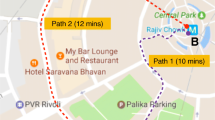Abstract
This paper proposes the optimal shortest path set problem in an undirected graph \(G=(V,E)\), in which some vehicles have to go from a source node \(s\) to a destination node \(t\). However, at most \(k\) edges in the graph may be blocked during the traveling. The goal is to find a minimum collection of paths for the vehicles before they start off to assure the fastest arrival of at least one vehicle, no matter which \(l\) \((0\le l\le k)\) edges are blocked. We consider two scenarios for this problem. In the first scenario with \(k=1\), we propose the concept of common replacement path and design the Least-Overlap Algorithm to find the common replacement path. Based on this, an algorithm to compute the optimal shortest path set is presented and its time complexity is proved to be \(O(n^2)\). In the second scenario with \(k>1\), we consider the case where the blocked edges are consecutive ones on a shortest path from \(s\) to \(t\) and the vertices connecting two blocked edges are also blocked (i.e., routes passing through these vertices are not allowed), and an algorithm is presented to compute the optimal shortest path set in this scenario with time complexity \(O(mn+k^2n^2\log n)\).










Similar content being viewed by others
References
Adhari H, Dreibholz T, Becke M (2011) Evaluation of concurrent multipath transfer over dissimilar paths. In: Proceedings of the 25th IEEE International Conference on Advanced Information Networking and Applications Workshops (WAINA) pp 708–714
Akgun V, Erkut E, Batta R (2000) On finding dissimilar paths. Eur J Oper Res 121(2):232–246
Bar-Noy A, Schieber B (1991) The canadian traveller problem. In: Proceedings of the second annual ACM-SIAM symposium on discrete algorithms. Society for Industrial and Applied Mathematics, pp 261–270
Dell’Olmo P, Gentili M, Scozzari A (2007) On finding dissimilar pareto-optimal paths. Eur J Oper Res 162(1):70–82
Dijkstra EW (1959) A note on two problems in connexion with graphs. Numer Math 1:269–271
Emek Y, Peleg D, Rodity L (2010) A near-linear-time algorithm for computing replacement paths in planar directed graphs. ACM Trans Algorithms 6(4):64
Eppstein D (1998) Finding the \(k\) shortest paths. SIAM J Comput 28(2):652–673
Fredman M, Tarjan R (1987) Fibonacci heaps and their uses in improved network optimization algorithms. J ACM 34(3):596–615
Hershberger J, Suri S (2001) Vickrey prices and shortest paths: what is an edge worth?. In: Proceedings of the 42nd IEEE Annual Symposium on Foundations of Computer Science (FOCS01) pp 252–259
Katoh N, Ibaraki T, Mine H (1982) An efficient algorithm for K shortest simple paths. Networks 12(4):411–427
Malik K, Mittal Ak, Gupta Sk (1989) The \(k\) most vital arcs in the shortest path problem. Oper Res Lett 8(4):223–227
Nardelli E, Proietti G, Widmayer P (1998) Finding the detour-critical edge of a shortest path between two nodes. Inform Process Lett 67(1):51–54
Nardelli E, Proiett G, Widmayer P (2001) A faster computation of the most vital edge of a shortest path. Info Process Lett 79(2):81–85
Wulff-Nilsen C (2010) Solving the replacement paths problem for planar directed graphs in \(O(n \log n)\) time. In: Proceedings of the 21th ACM-SIAM Symposium on Discrete Algorithms (SODA) pp 756–765
Xiao P, Xu Y, Su B (2009) Finding an anti-risk path between two nodes in undirected graphs. J Comb Optim 17(3):235–246
Xu Y, Hu M, Su B, Zhu B, Zhu Z (2009) The Canadian traveller problem and its competitive analysis. J Comb Optim 18(2):195–205
Yen JY (1971) Finding the K shortest loopless paths in a network. Manag Sci 17:712–716
Zhang H, Xu Y, Qin L (2013) The \(k\)-Canadian travelers problem with communication. J Comb Optim 26(2):251–265
Acknowledgments
The authors would like to acknowledge the financial support of Grants (Nos. 71071123 and 61221063) from NSF of China, Grant (No. IRT1173) from PCSIRT of China and Grant (No. 2014M550503) from China Postdoctoral Science Foundation funded Project.
Author information
Authors and Affiliations
Corresponding author
Rights and permissions
About this article
Cite this article
Zhang, H., Xu, Y. & Wen, X. Optimal shortest path set problem in undirected graphs. J Comb Optim 29, 511–530 (2015). https://doi.org/10.1007/s10878-014-9766-5
Published:
Issue Date:
DOI: https://doi.org/10.1007/s10878-014-9766-5




